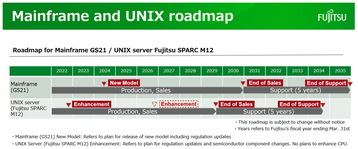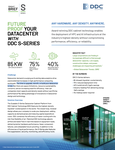Fujitsu has announced it is to end mainframe sales in 2030, with support due cease in 2035. It also announced plans to discontinue its UNIX SPARC servers in 2029, and end support in 2034.
Affected companies are faced with a choice to switch to another mainframe provider, which could be easier in the short term but potentially problematic long-term in an increasingly dwindling market; or completely re-architect applications on modern platforms, which poses significantly more challenges in the short term but can help future-proof applications.
“Fujitsu has created a new roadmap that includes a timetable for shifting its mainframes and UNIX servers to the cloud, gradually enhancing its existing business systems to optimize the experience for its end-users,” the company said in an announcement last week. “Fujitsu has indicated that it will discontinue sales of mainframes in fiscal 2030, concluding support services in fiscal 2035.
“Additionally, the roadmap plans for the discontinuation of sales of UNIX servers in fiscal 2029, and the end of related support services in fiscal 2034.”
The company said the move would ‘promote the modernization of its customers’ systems,' and said the 2030 timeframe would ‘ensure sufficient time and consideration for the transition.
According to a timeline posted alongside the announcement, the company will launch a new GSM21 mainframe model in 2024, and offer support until 2035. Customers can expect an ‘enhancement’ for Fujitsu’s UNIX SPARC server in late 2022 with new components, and possibly again in 2026.
In the future, Fujitsu said it aims to provide access to computing resources like HPC under an "as a service" business model via its new business brand, Fujitsu Uvance, which launched last year.
Fujitsu’s GSM21 mainframe line was last updated in 2018. The system has its roots in Amdahl Corporation, which had worked with the Japanese company since its inception in the 1970s before becoming a wholly-owned subsidiary in 1997. During the 2018 refresh, the company: “Fujitsu has set a new product roadmap, under which it will continue to provide products through 2030 and beyond, meeting the needs of customers who need to continue to utilize mainframes, as well as customers who are working to create new services by combining mission-critical systems with digital technology.”
Fujitsu aimed to sell 800 units across all mainframes worldwide during the three years from 2018 through to 2020; it's unclear if it met this sales target.
"Many of these mainframes are still around because the code is still running, and the business logic is tied to the hardware," Philip Dawson, vice president at Gartner Research, told the Register.
Dawson said that the situation will be somewhat different for Unix server users, as their workloads can be transitioned relatively easily to Linux.
"Linux has replaced Unix, basically. But that replacement isn't there for mainframes. When the hardware goes, what do you do with the applications?" he asked. "People have sweated their assets, and now they need to do something, soon. If you let it get to 2030 and you haven't started, you'll probably have left it too late.”
Despite the rush to adopt cloud computing, the global mainframe market remains a multi-billion dollar segment as companies still rely on their high throughput and reliability for critical high-volume transactions. Most of the large cloud providers are trying to wean customers off mainframes by launching mainframe modernization and migration services.
Last month, IBM confirmed the latest version of its z-series mainframe should launch ‘sometime after Q2 2022.'
On the SPARC side, the Register notes that 2034 is also the cut-off date of extended support for Oracle's Solaris operating system, which runs on the same Sparc processor architecture as Fujitsu's servers. Oracle announced the SPARC end of life in 2017.







